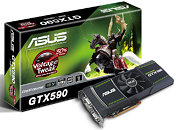Thursday, March 24th 2011

ASUS Releases its Dual-GPU GeForce GTX 590 with VoltageTweak
Presenting more graphics processing output than any single-board product developed to date, the ASUS GTX 590 uses dual NVIDIA GF110 cores. With ASUS exclusive Voltage Tweak to drive the card at 918MHz, it enables DirectX 11 gaming in the highest resolutions possible and with all details and effects turned on to maximum, as well as smooth and realistic 3D gaming and movies through NVIDIA 3D Vision Surround for three-screen displays.Product highlights
- Dual GF110 GPUs boost performance over the former top-of-the-line GTX 580 reference design, enhancing graphics processing capabilities for the strongest NVIDIA Fermi-based product delivered to date on a single circuit board. The large 3GB video memory allotment uses fast GDDR5 technology and a dual 384-bit memory interface for improved bandwidth and interconnectivity with other system components.
- The ASUS GTX 590 uses a core that runs at 612MHz, making it the fastest NVIDIA dual-core graphics card ever launched. ASUS exclusive overvolting utility Voltage Tweak takes advantage of this new power, allowing users with aggressive cooling to push the card further for up to 50% faster clock speeds at 918MHz. This represents very noticeable enhancements to in-game smoothness and responsiveness.
- Full support for NVIDIA 3D Vision Surround, driven by the capabilities of this dual-GPU card, easily handles full HD 3D output simultaneously on three displays.
- Two GPUs balanced and optimized on a single board mean the GTX 590 offers more than double the power of the GTX 580, running in always-on 2-way SLI by default.

24 Comments on ASUS Releases its Dual-GPU GeForce GTX 590 with VoltageTweak
www.youtube.com/watch?v=sRo-1VFMcbc&feature=player_embedded :laugh:
red-hot performance.
one of a kind experience!
technology you'll be talking (and laughing!) about for years to come!
"Hm, from first hand experience I'd have to disagree with the conclusion. I see a few reviews have had "peoblems" where the card has died, until we see some more real world testing from actual users I don't think that's something we can really pick at.
The way I see it, it's cheaper than 580 SLI, and offers a little less performance, while drawing less power and being quieter. Even with the fan turned up, it's not obnoxiously loud (too loud for me, but I'm a little obsessive with noise). Temperatures are great even without the fan turned up, and let's be honest - a large part of the target market for this card will be watercooling it anyway.
Overclock the card a little - we managed somewhere around 830 on the core from 607 stock, with a very minor voltage increase - and performance is niothing short of outstanding, with temperatures and noise still well within reason. With further tuning and better cooling, I don't think that 900 is an unreasonable expectation, possibly 950 or even higher with exotic cooling. Even with beta, unrefined drivers, it handily bested highly overclocked 480 SLI, 570 SLI, and 580 SLI.
Nvidia's SLI scaling is so much better with the Fermi cards than it used to be with, say, G92 or GT200, and I have to say I see so many less problems with their drivers than with ATi's.
I'm tempted by this card myself, but I really can't justify that amount of money - to need this card, you'd better be running a 2560x1440 or better monitor, or doing heavy 3D gaming, or using Nvidia Surround. For anything else apart from GPU-based computing, it's massive overkill. "
I left his typos in place :p
It does mean, however, that good samples *can* be had ;)
How do you deduce this?
Perhaps you missed this line?
So.. I don't get what you're saying :confused: